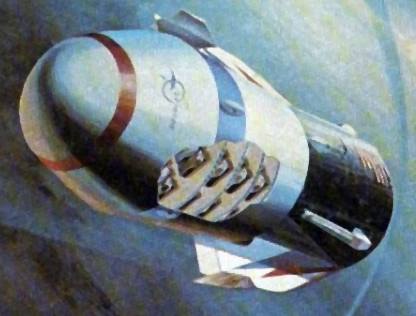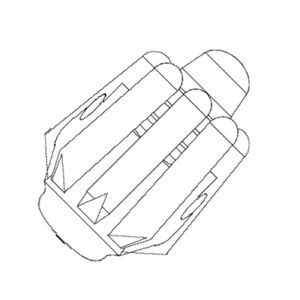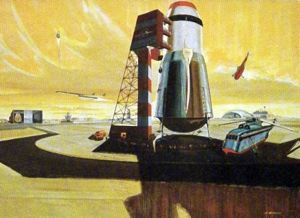
Home - Search - Browse - Alphabetic Index: 0- 1- 2- 3- 4- 5- 6- 7- 8- 9
A- B- C- D- E- F- G- H- I- J- K- L- M- N- O- P- Q- R- S- T- U- V- W- X- Y- Z
Pegasus VTOVL

Pegasus Reentry
Credit: NASA
Status: Study 1966. Payload: 90,800 kg (200,100 lb). Thrust: 18,700.00 kN (4,203,900 lbf). Gross mass: 1,520,000 kg (3,350,000 lb). Height: 34.80 m (114.10 ft). Diameter: 15.20 m (49.80 ft). Apogee: 560 km (340 mi).
The "Pegasus" was a Saturn V-class intercontinental rocket capable of transporting 170-260 passengers and 13-33.5t of cargo at 25,000km/h, or 90t to a 560km low Earth orbit. It would have been available in the 1980s and reduced the travel time from New York to Bombay from 22 hours to only 40 minutes. In Phil Bono's words:
"the SST would be just a small step in the direction of reducing transit time, whereas rocket-propelled vehicles would provide the ultimate in sub-orbital speed for transportation on the Earth's surface. The space age has equipped us with the technology for transporting emergency equipment to any disaster area on Earth in the time it would take for a bus ride across town, despite the conditions of aircraft runways upon arrival. In addition, diplomats, heads of state, chiefs of staff, as well as business executives, could be transported in person to consult, confer, inspect, decide and to lead in a manner currently impossible from distant shores, even with the aid from television."
Pegasus would have carried most of its hydrogen fuel in expendable drop tanks; hardly advisable for a low-cost suborbital launcher but necessary in order to improve the maneuverability of the rocket during reentry and landing since the vehicle then could be made much lighter and smaller. The projected gross liftoff mass was 1520t and the landing weight only 148t. The emergency landing procedure required all eight tanks to be jettisoned before the vehicle made an emergency landing on inflatable pontoons. Pegasus would have carried sixteen 1170KN thrust aerospike rocket modules so the engine-out safety would have been fairly good since only four engines were required for landing. The expected landing accuracy was only 1.6 * 3.2 kilometers so the spaceport would have to be located in a 5km wide uninhabited area for safe launch and landing operations.
Pegasus atmospheric reentry. The combined heatshield + plug nozzle rocket engine would be cooled by circulating liquid hydrogen fuel at the base of the vehicle. The intercontinental passenger version would incorporate fins between the external liquid hydrogen tanks to restrict reentry decelerations to a safe maximum of 2.5-3 g's. Pegasus would have been launched from spaceports which, by the 1980s, were expected to be established near most key cities throughout the world. Off-shore launch platforms were another possibility. Douglas estimated that the Pegasus would cost $3 billion (1964 $s -- $16.1B at 1999 rates) to develop, and the operational vehicles would cost $34M (=$183M in 1999 )per copy if two dozen were built. The first operational Pegasus would have cost $63 million (=$338M in 1999) to produce. According to Phil Bono, "we cannot afford to dismiss the rocket transport as a far-fetched impractical pipe dream. We must design today as if the next 10 years had already passed..."
Crew Size: 172.LEO Payload: 90,800 kg (200,100 lb) to a 560 km orbit at 28.00 degrees. Development Cost $: 3,000.000 million in 1966 dollars. Flyaway Unit Cost 1985$: 30.000 million in 1966 dollars.
Stage Data - Pegasus VTOVL
- Stage 0. 8 x Pegasus Tanks. Gross Mass: 20,000 kg (44,000 lb). Empty Mass: 3,700 kg (8,100 lb). Isp: 459 sec. Burn time: 130 sec. Isp(sl): 359 sec. Diameter: 4.57 m (14.99 ft). Span: 4.57 m (14.99 ft). Length: 18.90 m (62.00 ft). Propellants: Lox/LH2. No Engines: 0. Engine: None. Status: Study 1966. Comments: Four tanks jettisoned at 130 seconds after liftoff; two at 250 seconds, last two at orbital insertion, 360 seconds after liftoff.
- Stage 1. 1 x Pegasus VTOVL. Gross Mass: 1,250,000 kg (2,750,000 lb). Empty Mass: 148,000 kg (326,000 lb). Thrust (vac): 23,947.000 kN (5,383,499 lbf). Isp: 459 sec. Burn time: 360 sec. Isp(sl): 359 sec. Diameter: 10.00 m (32.00 ft). Span: 15.24 m (49.99 ft). Length: 34.76 m (114.04 ft). Propellants: Lox/LH2. No Engines: 1. Engine: Plug-Nozzle Pegasus. Status: Study 1966. Comments: Empty mass includes 29,600 kg of propellants used for re-entry cooling of plug nozzle and rocket soft landing at landing field.
Family: Manned spacecraft, orbital launch vehicle, SSTO. Country: USA. Engines: None, Plug-Nozzle Pegasus. Launch Vehicles: Pegasus VTOVL. Stages: Pegasus Tanks, Pegasus VTOVL stage. Agency: Douglas. Bibliography: 36, 517.
 | Pegasus SSTO Pegasus SSTO Launch Vehicle Credit: © Mark Wade |
 | Pegasus Landing Credit: NASA |
 | Pegasus Abort Credit: NASA |
 | Pegasus SSTO Pegasus SSTO Launch Vehicle Cutaway Credit: © Mark Wade |
Back to top of page
Home - Search - Browse - Alphabetic Index: 0- 1- 2- 3- 4- 5- 6- 7- 8- 9
A- B- C- D- E- F- G- H- I- J- K- L- M- N- O- P- Q- R- S- T- U- V- W- X- Y- Z
© 1997-2019 Mark Wade - Contact
© / Conditions for Use